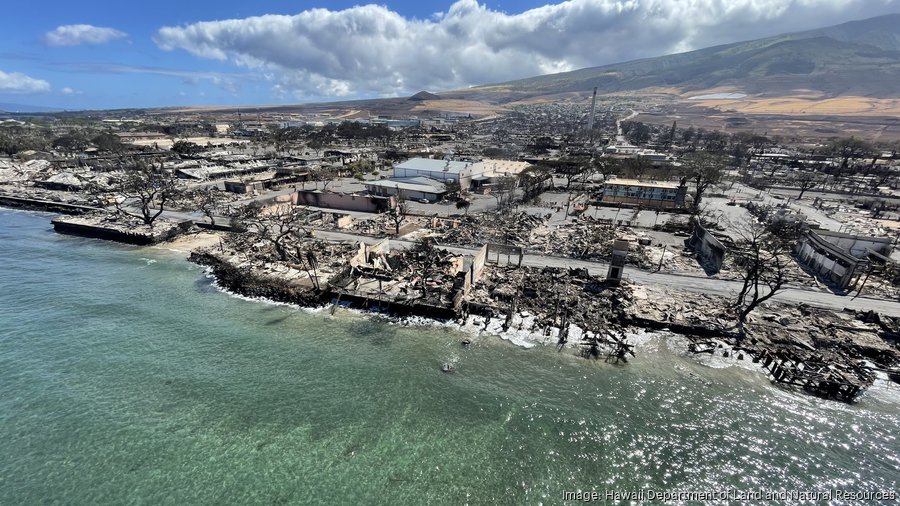Listen to this article 2 min
August wildfires that ravaged parts of Maui, killing nearly 100 and destroying much of historic Lahaina town, will have economic costs for Maui County and state as a whole, "many of which will will last well into the future," according to a third-quarter forecast from the Economic Research Organization at the University of Hawaii, or UHERO.
"Obviously the report is very much focused on Maui and what has turned into an extremely sharp downturn in economic activity across the island as a result of the fires and the loss of visitor spending," UHERO Executive Director Carl Bonham said during a virtual news conference last week.
In its first forecast since the wildfires, UHERO economists said Maui experienced a "severe economic disruption" following the fires, as visitor arrivals dropped by nearly three-quarters and the island lost more than $13 million of visitor spending each day in the weeks following the fire.
Before the fire, businesses in Lahaina, one of the most popular tourist destination on the Valley Isle, generated more than $70 million in monthly revenue in accommodations, food services, retail sales and other categories, the report noted.
However, according to the report, tourism recovery is beginning, with central and south Maui resorts expected to be the first areas to see "substantial recovery."
"The planned Oct. 8 reopening of unaffected West Maui resort areas will restart tourism in the region, although we expect recovery there to be gradual," the report said.
UHERO expects visitor arrivals to the Valley Isle to reach more than 50% of 2022 levels by the end of the year and 80% by the end of 2024.
"Gains will be gradual thereafter, because of continued temporary housing needs and lingering reluctance of some travelers," the report noted. "Tourism businesses will remain under considerable economic pressure. A complete recovery will not be reached within this forecast period."
Bonham said the recovery of the overall economy and the tourism economy will be influenced in 2024 and beyond by what happens with housing and the reconstruction phase, and the need to continue housing displaced residents, emergency workers and, eventually, construction workers.
"All of that will come together to essentially slow the process of recovery in the tourism space, but if you look at total payroll jobs in the Islands, we think that spending of federal dollars will actually make the job recovery look like it's faster than the tourism recovery — and it will be faster because of the money that's getting spent," he said, noting that spending by agencies like the American Red Cross, Environmental Protection Agency and others to address the disaster will help create jobs.
"The same thing is true when you look at the state as a whole," Bonham continued. "It will like like the state economy is doing well in 2025 and 2026, not so much in 2024. The impact on overall state economy [is] going to be muted because, while Maui is incredibly important to the overall state visitor industry, as a share of the overall economy, it's just a little bit more than 10% of the state economy," he said. "The overall state economy will weather this Maui downturn and we'll actually see a boost in overall economic activity — job growth and particularly construction activity — but overall GDP growth will be higher in '25 and '26 and '27 than we had forecast before the fires. ... The economy will grow more slowly and then it will rebound in sort of a typical fashion after a disaster."
Additionally, UHERO noted in the report:
- Fires destroyed most businesses and jobs in Lahaina, while businesses across the island are struggling with fewer visitors. Unemployment on Maui will soar above 11% in the fourth quarter and will not dip below 4% until late 2026.
- Homes made up 86% of the approximately 2,200 structures lost in the Lahaina blaze — or roughly 3% of Maui's housing stock. Rebuilding will take many years. The state and county are working to find longer-term housing for about 7,000 displaced people now being accommodated in hotels, timeshares and transient vacation rentals, while "an eventual army of construction laborers must also be housed. Until substantial rebuilding can be accomplished, these needs will press hard on the already tight and expensive Maui housing market."
- The spillover of fire-related economic impacts to the rest of the state, however, will be limited. "Because Maui represents a significant share of Hawaii tourism, aggregate visitor industry measures will, of course, fail. And the external conditions that underpin Hawaii tourism remain unsettled."
- Construction projects in other counties will have to compete with Maui's recovery needs, but in most sectors, UHERO does not expect significant changes from the forecast it was developing prior to the fires. Job growth statewide will dip below 2% this year and to 1% in 2024. The number of jobs thereafter will be " a bit above" previous forecasts as rebuilding ramps up.
- Statewide income growth will slow to below 2% next year, and while gross domestic product will rise somewhat by rebuilding, it doesn't capture the value of lost homes and business, or non-pecuniary costs.
- The reopening of West Maui will help reduce tax revenue losses, as will the county's 0.5% general excise tax surcharge, which is set to begin Jan. 1. The state General Council on Revenues has reduced its forecast for state general fund revenues for the 2024 fiscal year to 1.3% growth, down from an earlier estimate of 4%. Depending on the amount of federal funding, the state will incur "substantial recovery costs for at least the next half-decade."
The full report can be found online here.
